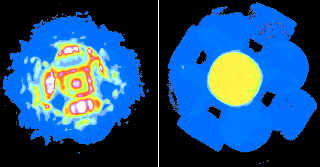Solving difficult structures with electron diffraction
 Electrons diffract in the same way as X-rays and neutrons, except that the electron wavelength is very small and the electron scattering cross-section is correspondingly much larger, about a million times that of X-rays. Since electron diffraction was discovered, transmission electron diffraction and the related electron imaging have developed into powerful tools for the analysis of defects, microstructure, surfaces and interfaces in a broad range of materials, so why haven’t more structures been solved with high-energy electrons?
Electrons diffract in the same way as X-rays and neutrons, except that the electron wavelength is very small and the electron scattering cross-section is correspondingly much larger, about a million times that of X-rays. Since electron diffraction was discovered, transmission electron diffraction and the related electron imaging have developed into powerful tools for the analysis of defects, microstructure, surfaces and interfaces in a broad range of materials, so why haven’t more structures been solved with high-energy electrons?
The short answer lies in electron dynamic diffraction: the same strong interaction between electrons and matter that gives rise to large electron scattering cross sections also gives rise to strong multiple scattering. A general method for solving unknown crystal structures using dynamic diffraction intensities has yet to be developed.
In a topical review two researchers [Midgley, P. & Eggeman, A. (2015). IUCrJ, 2, 126-136; doi:10.1107/S2052252514022283] describe progress made in the technique of precession electron diffraction (PED).
Using PED intensities, crystal structures can be solved by a combination of phasing and structure refinement.
The quality of electron diffraction data, as well as speed of acquisition, is increasing rapidly; thus in the not too distant future we can expect more identifications of new structures and their solutions.
[Zuo, J. M. & Rouviere, J. L. (2015). IUCrJ, 2, 7-8; doi:10.1107/S2052252514026797]


